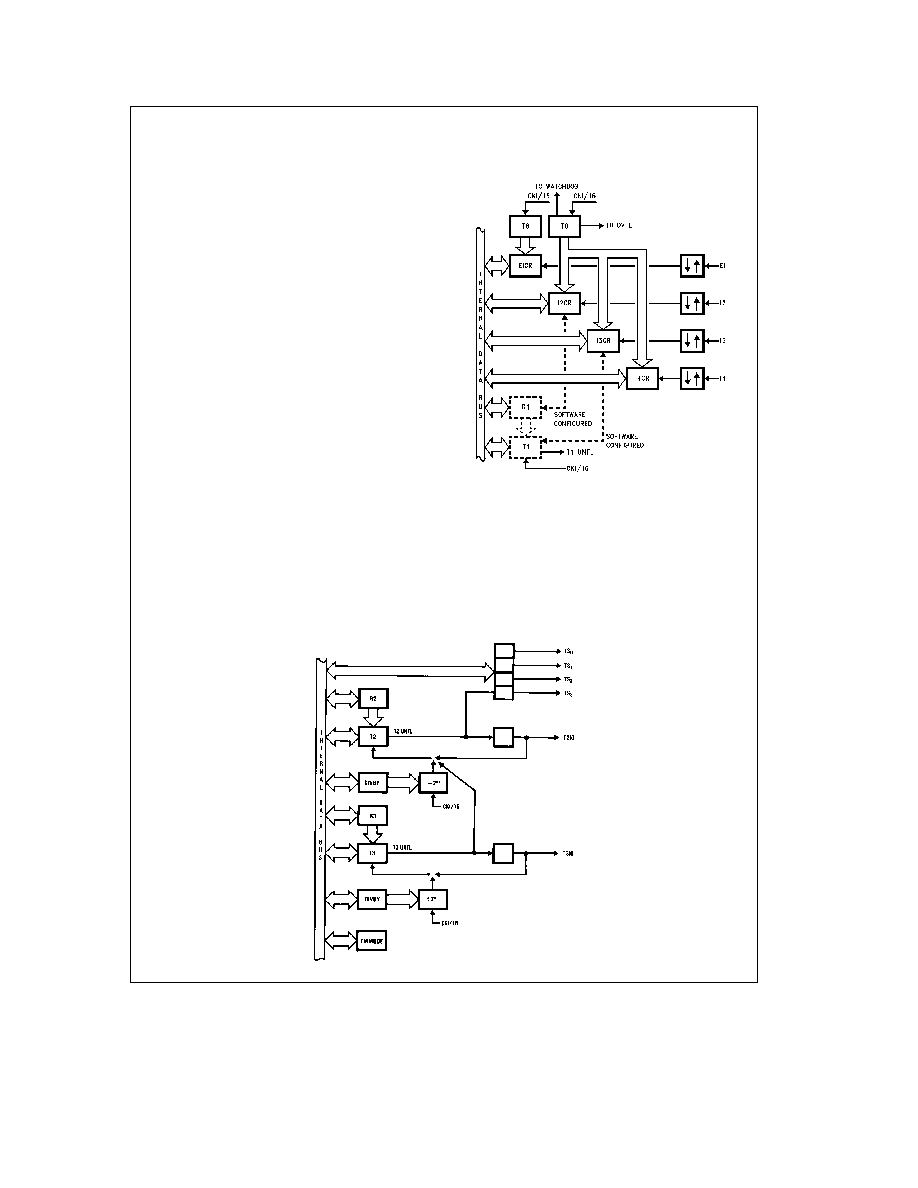- 您現(xiàn)在的位置:買(mǎi)賣(mài)IC網(wǎng) > PDF目錄296194 > HPC36083 (National Semiconductor Corporation) High-Performance microControllers PDF資料下載
參數(shù)資料
| 型號(hào): | HPC36083 |
| 廠商: | National Semiconductor Corporation |
| 英文描述: | High-Performance microControllers |
| 中文描述: | 高性能微控制器 |
| 文件頁(yè)數(shù): | 14/36頁(yè) |
| 文件大小: | 467K |
| 代理商: | HPC36083 |
第1頁(yè)第2頁(yè)第3頁(yè)第4頁(yè)第5頁(yè)第6頁(yè)第7頁(yè)第8頁(yè)第9頁(yè)第10頁(yè)第11頁(yè)第12頁(yè)第13頁(yè)當(dāng)前第14頁(yè)第15頁(yè)第16頁(yè)第17頁(yè)第18頁(yè)第19頁(yè)第20頁(yè)第21頁(yè)第22頁(yè)第23頁(yè)第24頁(yè)第25頁(yè)第26頁(yè)第27頁(yè)第28頁(yè)第29頁(yè)第30頁(yè)第31頁(yè)第32頁(yè)第33頁(yè)第34頁(yè)第35頁(yè)第36頁(yè)

Timer Overview
The HPC16083 contains a powerful set of flexible timers
enabling the HPC16083 to perform extensive timer func-
tions not usually associated with microcontrollers
The HPC16083 contains nine 16-bit timers Timer T0 is a
free-running timer counting up at a fixed CKI16 (Clock In-
put16) rate It is used for WATCHDOG logic high speed
event capture and to exit from the IDLE mode Conse-
quently it cannot be stopped or written to under software
control Timer T0 permits precise measurements by means
of the capture registers I2CR I3CR and I4CR A control bit
in the register TMMODE configures timer T1 and its associ-
ated register R1 as capture registers I3CR and I2CR The
capture registers I2CR I3CR and I4CR respectively record
the value of timer T0 when specific events occur on the
interrupt pins I2 I3 and I4 The control register IRCD pro-
grams the capture registers to trigger on either a rising edge
or a falling edge of its respective input The specified edge
can also be programmed to generate an interrupt (see
Fig-
ure 19 )
The HPC16083 provides an additional 16-bit free running
timer T8 with associated input capture register EICR (Ex-
ternal Interrupt Capture Register) and Configuration Regis-
ter EICON EICON is used to select the mode and edge of
the EI pin EICR is a 16-bit capture register which records
the value of T8 (which is identical to T0) when a specific
event occurs on the EI pin
The timers T2 and T3 have selectable clock rates The
clock input to these two timers may be selected from the
following two sources an external pin or derived internally
by dividing the clock input Timer T2 has additional capabili-
ty of being clocked by the timer T3 underflow This allows
the user to cascade timers T3 and T2 into a 32-bit timer
counter The control register DIVBY programs the clock in-
put to timers T2 and T3 (see
Figure 20 )
The timers T1 through T7 in conjunction with their registers
form Timer-Register pairs The registers hold the pulse du-
ration values All the Timer-Register pairs can be read from
or written to Each timer can be started or stopped under
software control Once enabled the timers count down and
upon underflow the contents of its associated register are
automatically loaded into the timer
TLDD8801 – 21
FIGURE 19 Timers T0 T1 and T8
with Four Input Capture Registers
SYNCHRONOUS OUTPUTS
The flexible timer structure of the HPC16083 simplifies
pulse generation and measurement There are four syn-
chronous timer outputs (TS0 through TS3) that work in con-
junction with the timer T2 The synchronous timer outputs
can be used either as regular outputs or individually pro-
grammed to toggle on timer T2 underflows (see
Figure 20 )
Timerregister pairs 4 – 7 form four identical units which can
generate synchronous outputs on port P (see
Figure 21 )
TLDD8801 – 22
FIGURE 20 Timers T2 – T3 Block
21
相關(guān)PDF資料 |
PDF描述 |
|---|---|
| HPC36400EV2 | High-Performance Communications MicroController |
| HPC46003 | High-Performance microControllers |
| HPC46083 | High-Performance microControllers |
| HPC46100VF40 | HPC46100 High-Performance microController with DSP Capability |
| HPC46100 | HPC46100 High-Performance microController with DSP Capability |
相關(guān)代理商/技術(shù)參數(shù) |
參數(shù)描述 |
|---|---|
| HPC36083XXX/E17 | 制造商:未知廠家 制造商全稱(chēng):未知廠家 功能描述:16-Bit Microcontroller |
| HPC36083XXX/L20 | 制造商:未知廠家 制造商全稱(chēng):未知廠家 功能描述:16-Bit Microcontroller |
| HPC36083XXX/L30 | 制造商:未知廠家 制造商全稱(chēng):未知廠家 功能描述:16-Bit Microcontroller |
| HPC36083XXX/T20 | 制造商:未知廠家 制造商全稱(chēng):未知廠家 功能描述:16-Bit Microcontroller |
| HPC36083XXX/T30 | 制造商:未知廠家 制造商全稱(chēng):未知廠家 功能描述:16-Bit Microcontroller |
發(fā)布緊急采購(gòu),3分鐘左右您將得到回復(fù)。